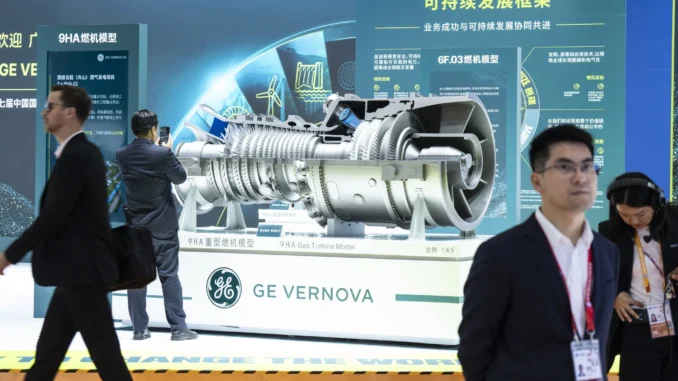
The energy sector is witnessing a transformative shift as artificial intelligence (AI) and data centers drive unprecedented demand for reliable power sources. GE Vernova, a leading player in the natural gas turbine market, is positioning itself at the forefront of this boom. According to CEO Scott Strazik, the company anticipates significant growth in gas turbine sales to hyperscalers—major tech firms like Amazon, Google, and Microsoft that operate vast cloud computing infrastructures.
Currently, about 90% of GE Vernova’s turbine orders come from traditional customers such as utilities and independent power producers, with hyperscalers accounting for just 10%. However, in paid reservations from early-stage developers, hyperscalers represent roughly a third of the pipeline, signaling a rapid pivot toward tech-driven energy needs.
This surge is closely tied to the explosive growth of AI, which requires immense computational power housed in sprawling data centers. These facilities are “spinning up” across the United States at a breakneck pace to support AI training, machine learning models, and cloud services. Natural gas turbines are emerging as a preferred solution for providing the baseload power these centers demand, offering reliability and quick scalability compared to intermittent renewables like solar or wind. As hyperscalers expand, they’re increasingly turning to on-site or dedicated power generation to bypass grid constraints, further boosting turbine sales.
Key Players in the U.S. Natural Gas Turbine Market
The U.S. natural gas turbine landscape is dominated by a handful of major manufacturers that control the majority of the market. Here’s a breakdown of the top players:
GE Vernova: As the world’s largest supplier of gas turbine technology, GE Vernova offers a wide range of aeroderivative and heavy-duty turbines tailored for power generation.
The company has seen new orders nearly triple year-over-year to 55 gigawatts, with projections reaching 60 gigawatts, largely fueled by data center demand.
Siemens Energy: A global heavyweight, Siemens provides high-efficiency gas turbines and has a strong presence in North America.
Alongside GE Vernova and Mitsubishi Power, it accounts for two-thirds of turbines in gas-fired power plants under construction worldwide.
Mitsubishi Power: This Japanese firm, part of Mitsubishi Heavy Industries, specializes in advanced gas turbines with cutting-edge technologies.
It’s a key supplier in the U.S. market and collaborates on projects involving AI-related infrastructure.
Other notable manufacturers include Rolls-Royce Holdings PLC, Capstone Turbine Corporation, and Solar Turbines Inc., which focus on smaller-scale or specialized applications.
These companies are ramping up production to meet the AI-driven energy surge, with many U.S.-based suppliers like Industrial Exchange Network and Adron Tool Corp. supporting the ecosystem through maintenance and components.
For broader energy news and insights on these developments, resources like Energy News Beat (energynewsbeat.co) provide ongoing coverage of the sector, though specific recent articles on GE Vernova’s hyperscaler pivot were not highlighted in our review.AI and Data Centers: Fueling the Energy Revolution
The rise of AI is reshaping how data centers operate. Traditional data centers consume significant electricity, but AI-optimized ones—designed for tasks like training large language models—can demand four times more power in the coming years.
In regions like West Texas, projects such as the $500 billion Stargate initiative from OpenAI and Oracle are incorporating natural gas-fired generation directly into their plans.
This “spinning up” involves not just building physical infrastructure but also securing energy sources that can handle peak loads without interruption. Natural gas turbines play a critical role here, providing efficient, low-emission power that complements renewables. As AI adoption accelerates, data centers are projected to contribute to a $1.8 trillion expansion by 2030, with power needs potentially reshaping utility partnerships and grid strategies.
Investment Opportunities in the AI Energy Boom
Investors eyeing this trend should focus on companies poised to benefit from the intersection of AI data centers and natural gas infrastructure. Here are key picks across turbines, utilities, and related sectors:
|
Company
|
Ticker
|
Why Invest?
|
|---|---|---|
|
GE Vernova
|
GEV
|
Dominant in gas turbines; orders surging due to data center demand; positioned for $25 trillion AI energy market.
investing.com
|
|
Siemens Energy
|
SMNEY
|
Major turbine manufacturer with global reach; benefits from hyperscaler shift.
|
|
Bloom Energy
|
BE
|
Fuel cell provider solving data center power issues; stock up 1,000% in a year on AI hype.
fortune.com
|
|
Cheniere Energy
|
LNG
|
Leading natural gas exporter; rising demand from data centers boosts LNG infrastructure.
money.usnews.com
|
|
Quanta Services
|
PWR
|
Infrastructure builder for power and data centers; key in AI expansion projects.
benzinga.com
|
|
Xcel Energy
|
XEL
|
Utility with renewable and gas mix; poised for data center growth.
benzinga.com
|
|
Williams Companies
|
WMB
|
Midstream natural gas player; surging transport demand from AI boom.
seekingalpha.com
|

Midstream firms like TC Energy (TRP), Kinder Morgan (KMI), and Energy Transfer (ET) also offer growth and income potential as natural gas flows increase.
For diversified exposure, consider ETFs focused on natural gas and energy infrastructure.
Is the Energy Demand Hype Real?
The buzz around AI’s energy appetite is intense, but opinions are divided. Proponents argue it’s genuine: Data centers are fueling enormous demand, with AI potentially transforming real estate and utilities.
However, skeptics point to overhype, drawing parallels to the dot-com bubble where electricity forecasts far exceeded reality.
Efficiency gains from AI itself—optimizing energy use in various sectors—may offset some demand, and projections often ignore replacements for outdated practices.
While the hype drives stock excitement, real growth is evident, though tempered by potential bubbles.
Will All Planned Data Centers Get Built?
Not likely. While plans are ambitious, implementation faces multifaceted challenges. Power and grid capacity top the list, with 72% of stakeholders citing it as the primary barrier.
Transmission delays, environmental concerns, and regulatory hurdles could intensify in 2025, stalling projects.
AI-specific needs like extreme cooling and density add complexity, requiring innovative designs and utility collaborations.
Overhyped forecasts might lead to overbuilding, but core demand suggests many will proceed, albeit with delays and adaptations.
In summary, GE Vernova’s outlook underscores a pivotal moment for the energy industry. As AI propels data center growth, natural gas turbines will remain essential, but investors should navigate the hype with caution, focusing on resilient players amid implementation uncertainties.
Got Questions on investing in oil and gas? Or do you have a Tax Burden in 2025?
Crude Oil, LNG, Jet Fuel price quote
ENB Top News
ENB
Energy Dashboard
ENB Podcast
ENB Substack





